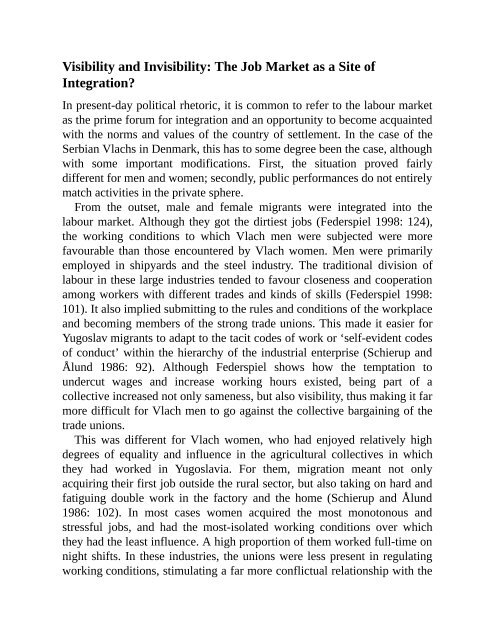Romanians from Serbia in Denmark
Create successful ePaper yourself
Turn your PDF publications into a flip-book with our unique Google optimized e-Paper software.
Visibility and Invisibility: The Job Market as a Site of<br />
Integration?<br />
In present-day political rhetoric, it is common to refer to the labour market<br />
as the prime forum for <strong>in</strong>tegrationand an opportunity to become acqua<strong>in</strong>ted<br />
with the norms and values of the country of settlement. In the case ofthe<br />
<strong>Serbia</strong>n Vlachs <strong>in</strong> <strong>Denmark</strong>, this has to some degree been the case, although<br />
with some important modifications. First, the situation proved fairly<br />
different for men and women; secondly, public performances do not entirely<br />
match activities <strong>in</strong> the private sphere.<br />
From the outset, male and female migrants were <strong>in</strong>tegrated <strong>in</strong>to the<br />
labour market. Although they got the dirtiestjobs (Federspiel 1998: 124),<br />
the work<strong>in</strong>g conditions to which Vlach men were subjected were more<br />
favourable than those encountered by Vlach women. Men were primarily<br />
employed <strong>in</strong> shipyards and the steel <strong>in</strong>dustry. The traditional division of<br />
labour <strong>in</strong> these large <strong>in</strong>dustries tended to favour closeness and cooperation<br />
among workerswith different trades and k<strong>in</strong>ds of skills (Federspiel 1998:<br />
101). It also implied submitt<strong>in</strong>g to the rules andconditions of the workplace<br />
and becom<strong>in</strong>g members of the strong trade unions. This made it easier for<br />
Yugoslavmigrants to adapt to the tacit codes of work or ‘self-evident codes<br />
of conduct’ with<strong>in</strong> the hierarchy of the<strong>in</strong>dustrial enterprise (Schierup and<br />
Ålund 1986: 92). Although Federspiel shows how the temptation to<br />
undercut wages and <strong>in</strong>crease work<strong>in</strong>g hours existed, be<strong>in</strong>g part of a<br />
collective <strong>in</strong>creased not only sameness, but alsovisibility, thus mak<strong>in</strong>g it far<br />
more difficult for Vlach men to go aga<strong>in</strong>st the collective barga<strong>in</strong><strong>in</strong>g of the<br />
tradeunions.<br />
This was different for Vlach women, who had enjoyed relatively high<br />
degrees of equality and <strong>in</strong>fluence <strong>in</strong> the agricultural collectives <strong>in</strong> which<br />
they had worked <strong>in</strong> Yugoslavia. For them, migration meant not only<br />
acquir<strong>in</strong>gtheir first job outside the rural sector, but also tak<strong>in</strong>g on hard and<br />
fatigu<strong>in</strong>g double work <strong>in</strong> the factory and the home (Schierup and Ålund<br />
1986: 102). In most cases women acquired the most monotonous and<br />
stressful jobs, and had the most-isolated work<strong>in</strong>g conditions over which<br />
they had the least <strong>in</strong>fluence. A high proportion of themworked full-time on<br />
night shifts. In these <strong>in</strong>dustries, the unions were less present <strong>in</strong> regulat<strong>in</strong>g<br />
work<strong>in</strong>gconditions, stimulat<strong>in</strong>g a far more conflictual relationship with the
















